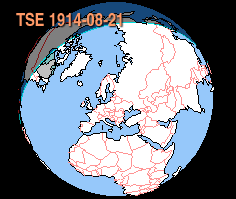Solar eclipse of August 21, 1914
| Solar eclipse of August 21, 1914 | |
|---|---|
 Animation of the total solar eclipse of August 21, 1914 |
|
| classification | |
| Type | Total |
| area |
North Africa , Europe , Western Asia , Northeastern North America Total: Canada , Greenland , Norway , Sweden , Russia , Turkey , Iraq , Iran , Pakistan , India |
| Saros cycle | 124 (49 of 73) |
| Gamma value | 0.7654 |
| Greatest eclipse | |
| Duration | 2 minutes 15 seconds |
| place | Russian Empire , today's Belarus |
| location | 54 ° 28 ′ N , 27 ° 4 ′ E |
| time | August 21, 1914 12:34:09 UT |
| size | 1.0328 |
The totality zone of the total solar eclipse of August 21, 1914 extended over North America , Europe and Asia .
course
At around 11:25 a.m. (all times in Universal Time , UT) the eclipse started over the far north of Canada . Then the sun darkened in Greenland and around 12:15 pm the umbra arrived in Norway . Then he moved over Scandinavia and then reached the Russian Empire , where the eclipse maximum was reached on Lake Naratsch . By 1:00 p.m. the darkness reached the Crimea . It then moved across the Black Sea to the Ottoman Empire (now Turkey ) and then to Persia (now Iran ), where it ended around 1:43 p.m. off the coast of British India (now India ).
Others
The eclipse occurred a few days after the beginning of the First World War . In Gumbinnen (today Gussew ), where the day before Russians and Germans had fought in the battle of Gumbinnen , the sun was about 96% darkened. An influence on the fighting, as was the case for the solar eclipse in 585 BC. Chr. Has been handed down, but did not have it.